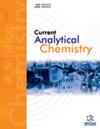基于荧光共振能量转移的简易光传感器用于快速检测水中和食品中的镉(II)含量
IF 1.7
4区 化学
Q3 CHEMISTRY, ANALYTICAL
引用次数: 0
摘要
研究目的本研究旨在利用荧光共振能量转移(FRET)技术开发一种新型荧光测定适配传感器,用于检测水和食品样品中的镉(II)(Cd2+)。所构建的适配传感器采用了一种荧光团-淬灭剂标记的适配体组合,这是以前从未报道过的用于 Cd2+ 检测的方法。此外,这种简单的混合检测模式无需固定或材料辅助步骤,是一种创新设计。方法:利用 6-羧基荧光素(FAM)修饰的适配体和马来酰亚胺(BHQ-1)修饰的适配体互补链构建荧光检测探针,该适配传感器实现了对 Cd2+ 的快速、灵敏和选择性检测。在没有 Cd2+ 的情况下,适配体及其互补链发生碱基配对,使 FAM 靠近 BHQ-1,从而产生 FRET,荧光强度随之降低。Cd2+ 的引入会优先作用于aptamer,改变其构象,阻止 BHQ-1 对 FAM 的淬灭,从而恢复aptasensor 的荧光强度。结果优化实验参数后,该适配体传感器对浓度为 5 至 1200 nM 的 Cd2+ 具有线性响应,检测限(LOD)为 0.43 nM。该传感器的性能不受各种离子的影响,这表明它具有很高的特异性。此外,它还能快速、准确地检测自来水、湖水、葡萄、卷心菜和西兰花等水和食物样品中的 Cd2+,显示了其巨大的实际应用潜力。结论因此,所开发的适配传感器是有效检测水和食品基质中 Cd2+ 的重要工具,凸显了其作为环境监测和食品安全重要工具的潜力。本文章由计算机程序翻译,如有差异,请以英文原文为准。
A Simple Aptasensor Based on Fluorescence Resonance Energy Transfer for the Rapid Detection of Cadmium (II) In Water And Food
Objective: The objective of this study is to develop a novel fluorometric aptasensor employing fluorescence resonance energy transfer (FRET) for the detection of Cadmium (II) (Cd2+) in water and food samples. The constructed aptasensor employed a fluorophore-quencher labeled aptamer combination not previously reported for Cd2+ detection. Additionally, its simple mix-anddetect pattern without immobilization or material-assisted steps represented an innovative design. Methods: Utilizing 6-carboxyfluorescein (FAM)-modified aptamers and maleimide (BHQ-1)- modified aptamer complementary chain to construct a fluorescent detection probe, this aptasensor achieved a rapid, sensitive, and selective detection of Cd2+. Without Cd2+, the aptamer and its complementary strand undergo base pairing, bringing the FAM closer to the BHQ-1, leading to FRET and a subsequent decrease in fluorescence intensity. The introduction of Cd2+ preferentially brought to the aptamer, changing its conformation and preventing the quenching of FAM by BHQ-1, thereby restoring the fluorescence intensity of the aptasensor. Results: Following optimization of experimental parameters, the aptasensor exhibited a linear response to Cd2+ concentrations ranging from 5 to 1200 nM, with a detection limit (LOD) of 0.43 nM. The aptasensor’s performance was unaffected by the presence of various ions, indicating its high specificity. Moreover, it could rapidly and accurately detect Cd2+ in water and food samples, including tap water, lake water, grapes, cabbage, and broccoli, demonstrating its substantial potential for practical application. Conclusion: Therefore, the developed aptasensor represents an important tool for effective Cd2+ detection in water and food matrices, highlighting its potential as a critical tool for environmental monitoring and food safety.
求助全文
通过发布文献求助,成功后即可免费获取论文全文。
去求助
来源期刊

Current Analytical Chemistry
化学-分析化学
CiteScore
4.10
自引率
0.00%
发文量
90
审稿时长
9 months
期刊介绍:
Current Analytical Chemistry publishes full-length/mini reviews and original research articles on the most recent advances in analytical chemistry. All aspects of the field are represented, including analytical methodology, techniques, and instrumentation in both fundamental and applied research topics of interest to the broad readership of the journal. Current Analytical Chemistry strives to serve as an authoritative source of information in analytical chemistry and in related applications such as biochemical analysis, pharmaceutical research, quantitative biological imaging, novel sensors, and nanotechnology.
 求助内容:
求助内容: 应助结果提醒方式:
应助结果提醒方式:


